Executive summary
What happened
On 16 April 2022, at approximately 0805 local time, the pilot of Beechcraft B58 Baron aircraft registered VH-NPT commenced a straight in approach to runway 12 at the East Kimberley Regional Airport with one passenger and 4 boxes of cargo on-board. The pilot reported that when they attempted to extend the landing gear they received multiple unusual indications, followed by an electrical burning smell, and saw smoke emerge from forward of the pilot’s circuit breaker panel near their left leg.
The pilot made a PAN-PAN call to air traffic control, activated the SOS function on the dash mounted Spider Tracks unit and recalled switching off electrical power. By this time flames were emerging from where the smoke had previously been observed. The pilot then expended the entire contents of a handheld portable fire extinguisher, however the fire quickly returned and intensified.
Flames and thick smoke filled the cockpit preventing the pilot from effectively seeing external visual references or the aircraft’s flight instruments. The aircraft subsequently diverged from the runway centreline track and collided with terrain approximately 800m from the threshold of runway 12.
Following the collision, the pilot extricated themselves from the inverted aircraft. The pilot then re‑entered the aircraft and, with limited assistance from the semi-conscious passenger, extracted them from the aircraft before it was consumed by a significant post impact fire. The passenger succumbed to their injuries and the pilot received serious injuries.
What the ATSB found
The ATSB determined that a fault associated with the landing gear electrical system likely ignited fuel from the cabin heater supply line, resulting in a significant and sustained cockpit fire.
The ATSB also determined that the pilot’s injuries were likely less severe due to the use of a 4‑point restraint. Additionally, while not required by regulation, the use of a rearward facing passenger seat is likely to reduce the severity of frontal impact‑related passenger injuries.
What has been done as a result
In response to this accident the operator reported that they:
- commenced a program to install 4-point restraints in the crew seats of all their B58 aircraft
- installed an additional fire extinguisher in each of their B58 aircraft
- incorporated additional 100-hourly fuel line and wiring inspections in the vicinity of the heater fuel line and circuit breakers adjacent to the pilot’s seat.
The ATSB issued a Safety Advisory Notice encouraging operators of B58 aircraft to conduct a detailed examination of the wiring and heater fuel line on the left side of the aircraft, forward of and below the pilot’s circuit breaker panel.
Safety message
Damaged electrical wiring can pose a range of hazards to the safety of flight, including loss of electrical power, malfunctioning systems, and inflight fire. This hazard is further increased when wiring is proximal to lines carrying flammable liquid. Maintenance organisations and operators should review current practices for the prevention of damage to wiring and ensure that all available steps are being taken. These may include inspections, appropriate stand-offs, and utilisation of anti-chafe sleeving.
The ATSB continues to encourage the utilisation of devices that may increase the survivability in light aircraft accidents.
- Four-point restraints, where available, provide increased survivability over 3-point restraints.
- Where available and practical, use of rearward facing passenger seats improves frontal impact protection and survivability in an accident.
Pre-flight
In the morning of 16 April 2022, the pilot of a Beechcraft B58 Baron (B58) registered VH-NPT (NPT) arrived at Aviair Pty Ltd, at Broome Airport to prepare for a regular charter flight to several remote locations in northern Western Australia. The operator’s duty maintenance officer (maintainer) reported that the pilot contacted them by phone before the flight, reporting a ‘fuel kind of smell’ in the aircraft’s cockpit. The maintainer recalled discussing the basics of the aircraft’s fuel system and asking the pilot to monitor the situation and report back if the smell did not go away.
The flight
The flight, with one passenger, seated in the rear right seat, and 4 boxes of cargo onboard, was planned to transit through the East Kimberley Regional Airport at Kununurra (Figure 1), refuel, then continue to Halls Creek where the passenger was to disembark, Fitzroy Crossing to unload cargo and then return to Broome via Derby.
Figure 1: Flight area with planned stops

Source: Google Earth annotated by the ATSB
The aircraft departed Broome at 0613 local time and climbed to 9,000 ft while tracking to the north-east. The maintainer, reported that at 0628 the pilot contacted them again, advising that the ’fuel like smell’ detected on the ground was no longer present.
At 0749 the pilot contacted air traffic control (ATC) and requested traffic for a direct track to waypoint Kununurra Whiskey Foxtrot (KNXWF) for an approach to runway 12 at Kununurra (Figure 2). At 0817 the pilot of NPT contacted ATC advising that they were leaving their cruising altitude of 9,000 ft on descent for Kununurra.
Figure 2: NPT flight path and Brisbane Centre radio calls
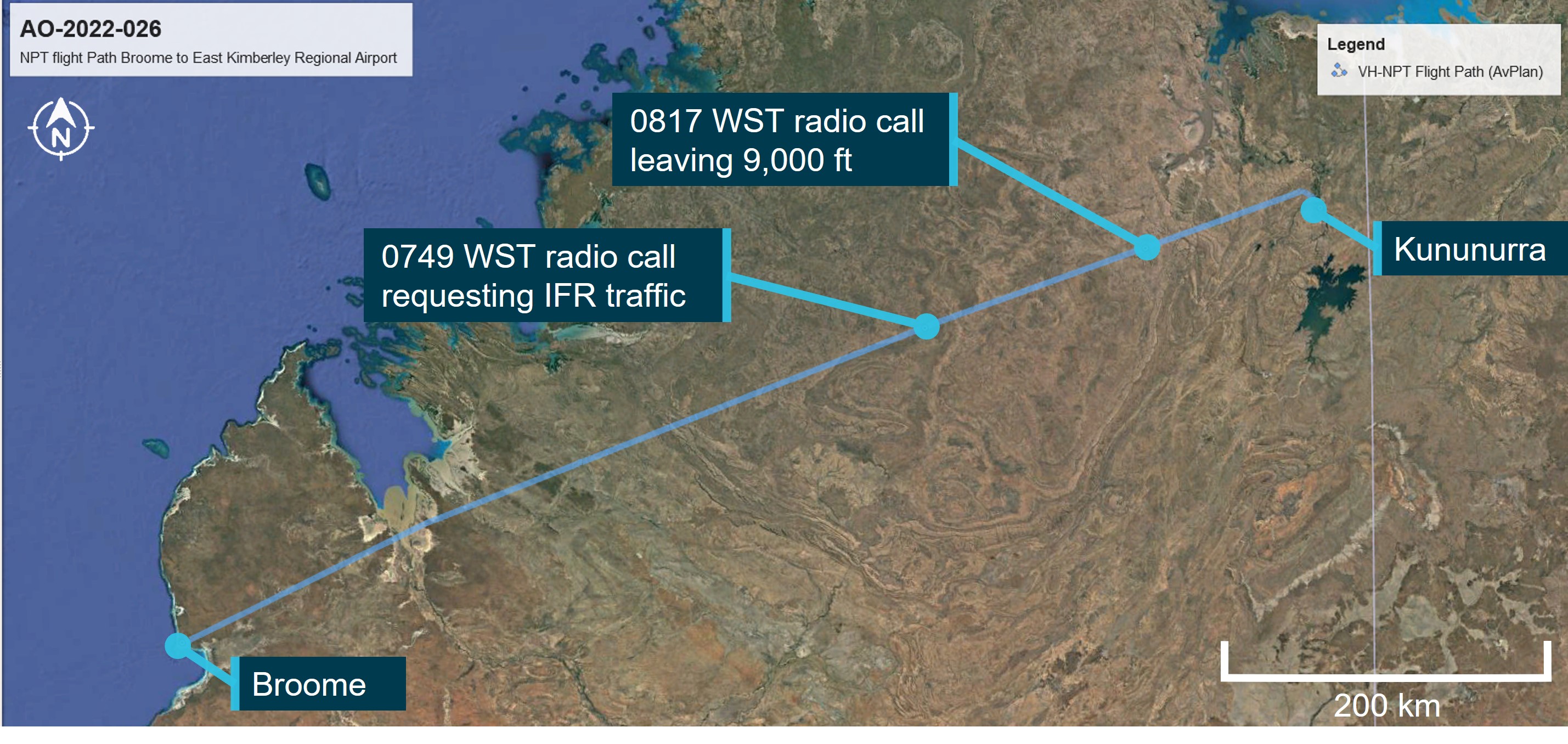
Source: Google Earth and AvPlan annotated by the ATSB
The approach
Seventeen minutes later NPT joined a straight in approach to runway 12. The pilot recalled slowing the aircraft, extending the first stage of flaps, and attempting to extend the landing gear.
Upon selecting the landing gear handle to the down position, the gear down and locked indicators (3 green lights) illuminated immediately. The pilot reported that this was unusual, as normal operation required a few seconds for the landing gear to extend and the lights to illuminate. However, no sound was heard from the landing gear motor and no decrease in aircraft performance was felt that would indicate gear had extended. The pilot also recalled, co‑incident with the landing gear handle activation, that the landing gear warning horn erroneously activated. The pilot stated that these unusual indications were followed immediately by an electrical burning smell and smoke emerging from below the left side of the aircraft instrument panel, forward of the pilot’s circuit breaker panel.
About a minute later, at 0836, the pilot made a PAN-PAN[1] call on the Brisbane Centre frequency advising of smoke and suspected fire in the cockpit. The pilot then activated the SOS[2] function on a dash mounted Spider Tracks[3] unit. The pilot recalled switching off the electrical power to the aircraft, in accordance with the electrical smoke and fire emergency procedure. They also reported switching off the avionics master switch (see the section titled Electrical system) as an additional precaution. By that time flames were emanating from the same location as the previously observed smoke.
The pilot then expended the entire contents of the aircraft’s handheld portable fire extinguisher, while continuing the straight in approach to runway 12 (Figure 3). However, the fire almost immediately returned, emanating from the same location, with flame and significant smoke in the cockpit. The pilot reported difficulty maintaining control of the aircraft as their left hand and leg were exposed directly to the flames and the smoke prevented them seeing both the instruments and the outside environment. In response, they opened the aircraft’s storm window[4] in an attempt to clear the smoke and obtain a visual reference.
Figure 3: NPT approach to East Kimberley Regional Airport
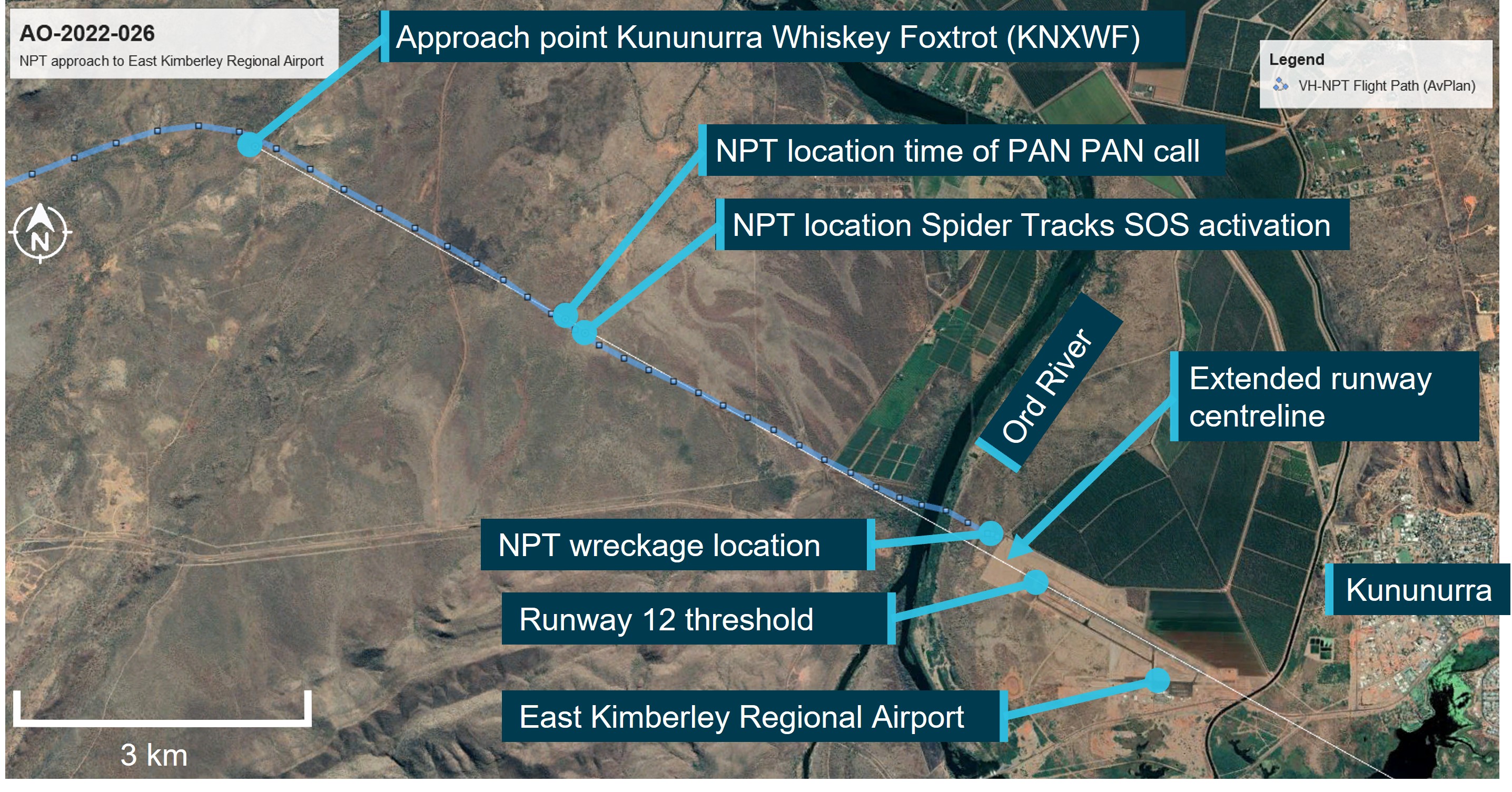
Source: Google Earth, AvPlan and Airservices Australia, annotated by the ATSB
As the aircraft approached the Ord River, multiple airborne witnesses reported that it appeared to be below the standard approach profile and ‘skimming the treetops.’
Recorded flight data indicated that, at 0837, the aircraft started diverging left of the extended runway centre line, crossing the Ord River at low level approximately 1.5 km from the threshold of runway 12. The aircraft subsequently collided with terrain, coming to rest inverted about 600 m beyond the river and about 800 m from the runway 12 threshold (Figure 3) and was consumed by a significant post‑impact fire.
Several pilots who were listening to the Brisbane Centre frequency reported hearing a transmission of static at the approximate time of the collision with terrain.
Post impact actions
The pilot reported difficulty in releasing themselves from the restraint and exiting the inverted aircraft. After exiting the aircraft, they attempted to access the passenger through the rear doors but were unable to due to the presence of significant smoke and flame. The pilot then re‑entered the aircraft through the crew door and located the passenger who was still secured in their restraint. The pilot, with limited assistance from the semi‑conscious passenger, undid the restraint and proceeded to extract the passenger from the aircraft. Shortly after the pilot and passenger exited the aircraft, the pilot collapsed, and operator personnel arrived and moved them to a safe distance from the wreckage.
The passenger succumbed to their injuries at the accident site. The pilot suffered serious injuries and was airlifted from the site to East Kimberley Regional Airport for transfer to the Kununurra Hospital before being transferred to Darwin for further treatment.
Context
Aircraft Information
NPT was a Beechcraft B58, low-wing, twin engine aircraft (Figure 4). It was manufactured in the United States in 1996 and first registered in Australia in 2012. The aircraft was fitted with 2 Continental IO-550-C piston engines, driving 3‑blade constant‑speed propellers.
Figure 4: VH-NPT at the time it was purchased by the operator
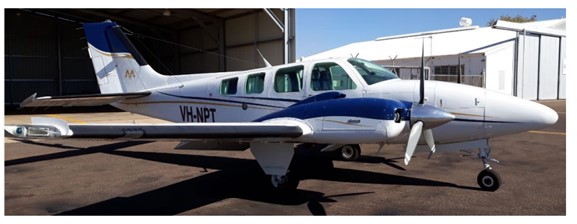
Source: Operator
NPT was acquired by the operator in 2019. It was configured for charter operations with seating for up to 4 passengers in a club[5] configuration and seating for 2 pilots. The aircraft was configured with dual flight controls.
Access to the aircraft was through one of 2 doors, a crew door located on the front right of the aircraft next to the co-pilot’s seat, providing access to the front seats. Two rear or ‘barn doors’ on the right side of the aircraft provide access to the rear cabin for the loading of persons and freight (Figure 5). The aircraft was also fitted with an emergency exit window on the left side of the aircraft next to the left rearward facing passenger seat. This window could be opened by a passenger in the event of an emergency. The pilot reported that instruction on its operation was included in the pre-flight briefing to the passenger.
Figure 5: Aircraft schematic identifying location of key elements
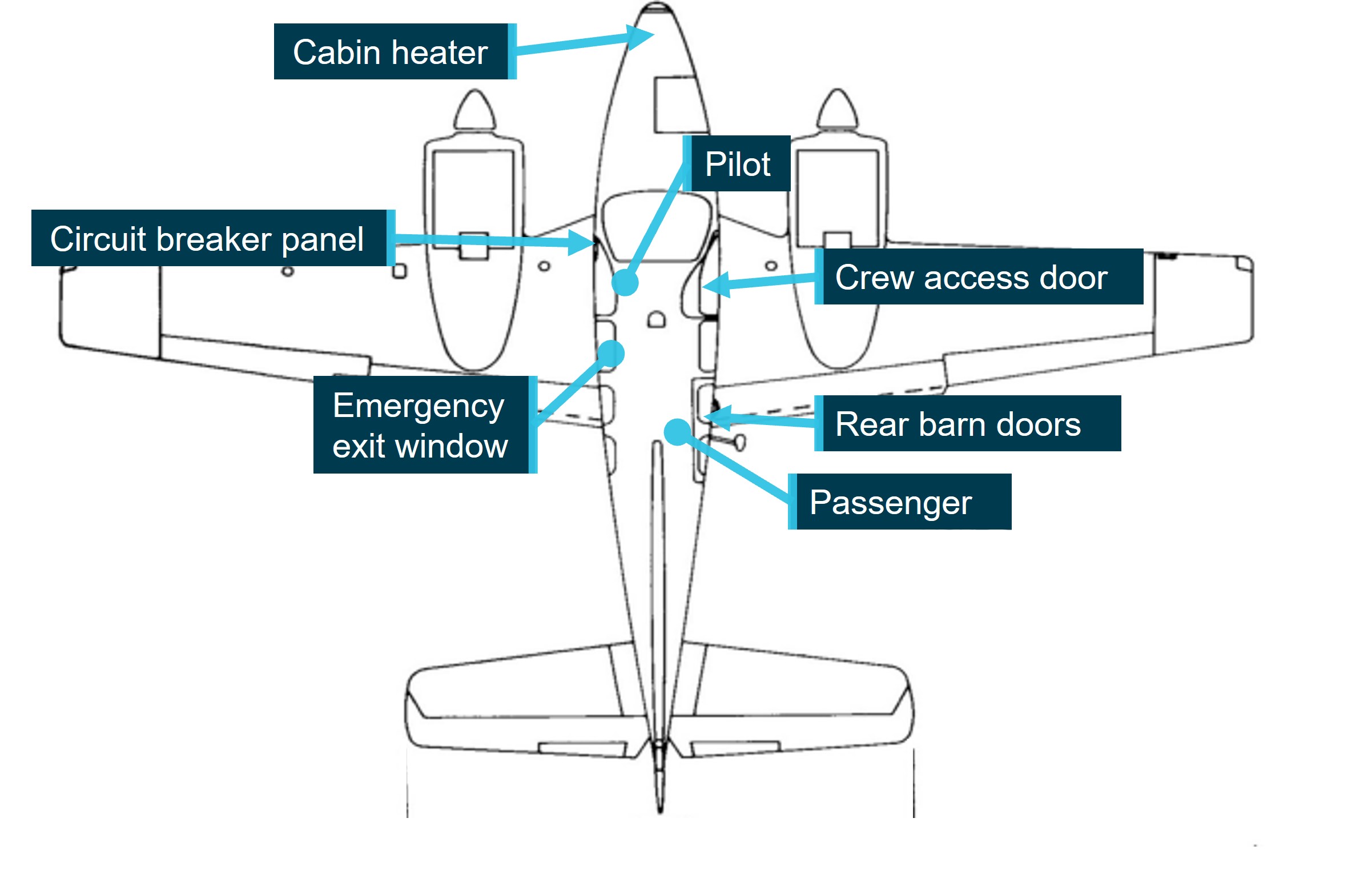
Source: Manufacturer annotated by the ATSB
Weight and balance
Prior to departure the pilot determined that the aircraft would be within weight and balance limitations for each leg of the flight using the operator’s approved spreadsheet for NPT. The ATSB obtained a copy of the approved spreadsheet for NPT and confirmed the pilot’s calculations. This assessment also indicated that for the legs of the flight that the passenger was onboard, the aircraft remained within balance limits irrespective of the seat occupied by the passenger.
Fire suppression
In accordance with the manufacturer’s requirements, NPT was fitted with a handheld portable 2 kg halon fire extinguisher for emergency use by the crew. The extinguisher was located centrally between the pilots’ seats and the rearward facing passenger seats. The extinguisher was inspected and reweighed as part of the last 100 hourly inspection in accordance with Civil Aviation Safety Authority requirements.
The pilot commented that, while they were able to access and utilise the extinguisher, its positioning made it more difficult to access in the event of an emergency than in other aircraft within the fleet.
Electrical system
Aircraft power was supplied by a single battery and an alternator fitted to each of the aircraft’s 2 engines. These power sources could be connected and disconnected individually using 3 separate switches on the pilot’s sub‑panel labelled ‘MASTER’ (Figure 6). To protect the avionics from electrical damage when the master switches were being operated, a separate ‘AVIONICS MASTER’ switch (Figure 6) controlled power to these devices. The ‘AVIONICS MASTER’ was dependant on the ‘MASTER’ switches in the control hierarchy, meaning that if the ‘MASTER’ switches were off, the ‘AVIONICS MASTER’ was not able to be powered.
Figure 6: Schematic of the pilot’s subpanel showing master power and landing gear controls
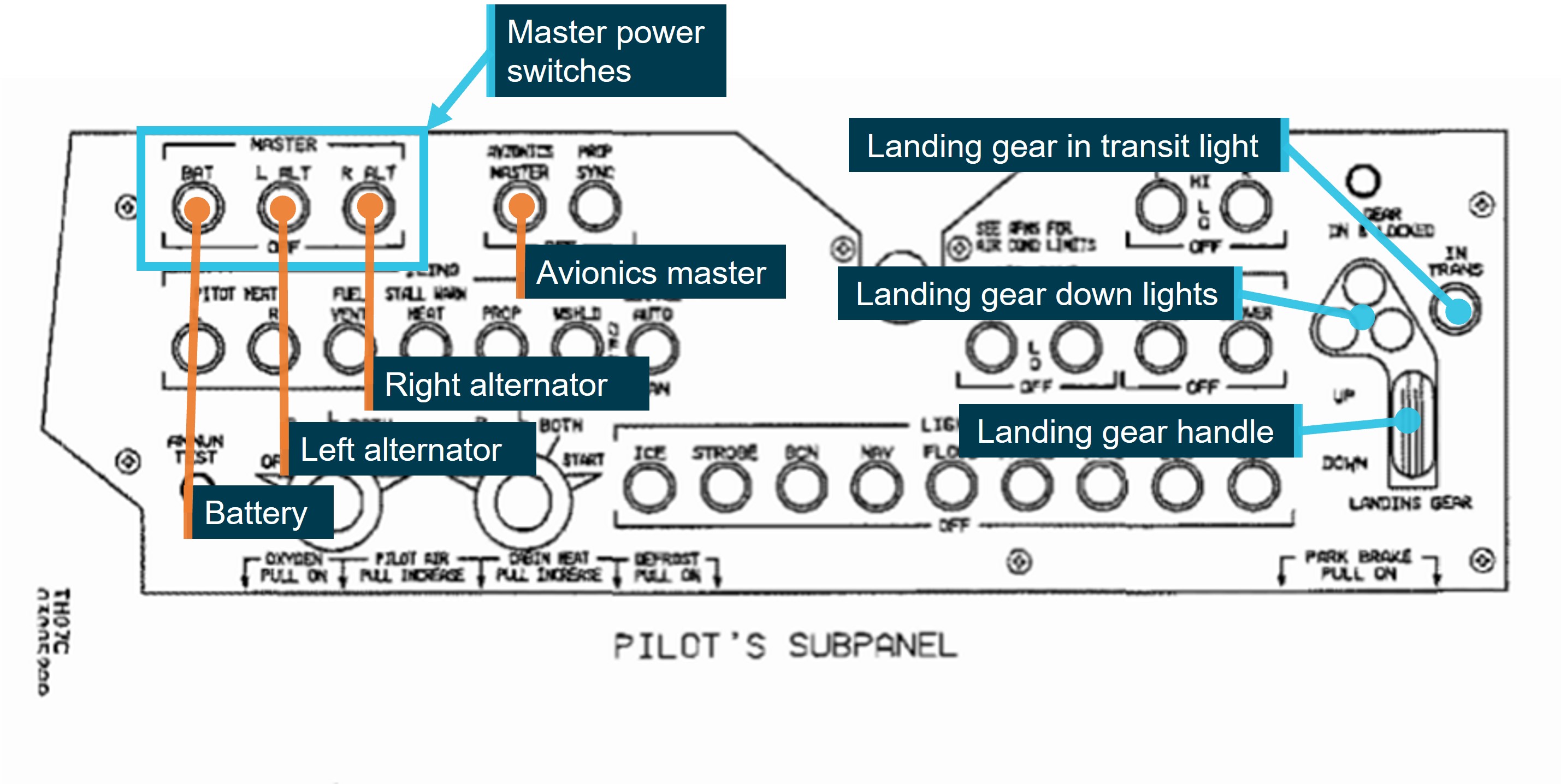
Source: Manufacturer annotated by the ATSB
Electrical power was supplied to several systems including drive motors for the landing gear and flaps, aircraft lighting, avionics and communications. A circuit breaker panel on the pilot’s left side protects the circuits from overload and damage. Wiring was routed from the circuit breaker and instrument panels down along the left side of the aircraft in a series of looms. Figure 7 shows the area forward of the circuit breaker panel and below the pilot’s instrument panel in an exemplar aircraft.
Figure 7: Circuit breaker and instrument panel of an exemplar B58 showing the position of wiring looms.
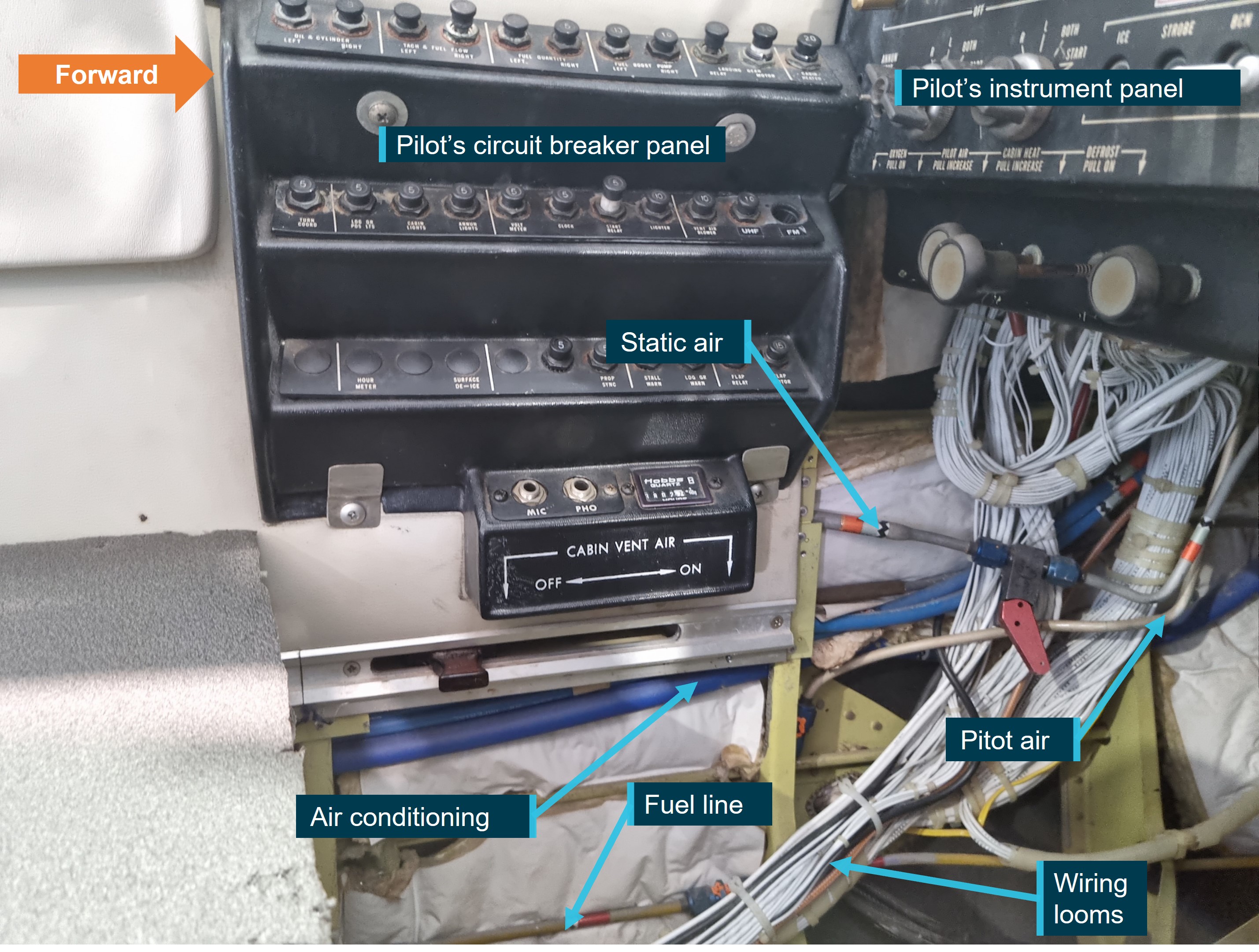
Source: Operator annotated by the ATSB.
Based on the pilot’s report of the abnormal landing gear behaviour, the ATSB conducted a detailed examination of the system function. The landing gear system consists of:
- a motor driving the gear between the extended and retracted positions
- an indicating system that identifies to the pilot when the gear is retracted, extended or in transit
- an aural alert that the gear is not extended if the aircraft is otherwise configured for landing.
Landing gear motor
The landing gear handle (Figure 6) acts as an electrical switch closing either the retract or extend landing gear motor circuit and powering the motor. Current flows through the switch and landing gear limit switches[6] to the motor relays. They are connected to the pilot’s circuit breaker panel by wiring on the left side of the aircraft and protected by a 5-amp circuit breaker. The relays operate a separate 30-amp circuit providing power directly to the landing gear motor. The switches and relays within the gear motor system provide power, with the motor constantly grounded. The landing gear motor is located below the floor of the aircraft between the crew and passenger seats.
Landing gear indication
The landing gear indication system consists of 4 lights, including one for each of the left, right and nose gears indicating they are in the down and locked position. A fourth light indicates that the gear is in transit. The lights are positioned above the gear handle on the instrument panel on the pilot’s subpanel assembly (Figure 6).
The lights are connected to down-lock and up-lock switches on each of the gear. The in-transit light is illuminated when either the down-lock or up-lock switches on any of the gear are not depressed. Once the down lock switches on each gear is closed, the light for that gear is switched on and once all 3 down lock switches are activated, the in-transit light switches off. These lights are connected to a 5-amp power supply and are switched on by grounding the circuit through these switches.
Landing gear warning
The landing gear warning system warns the pilot if the aircraft is incorrectly configured for landing due to the gear not being extended. The system consists of a warning horn connected to flap, throttle, and landing gear position switches. The horn will activate if the flaps are extended to full and the throttles are retarded while the landing gear is selected up.
The wiring for these systems, and several other electrical systems, are bundled together in the area where the pilot reported the fire started. The ATSB’s review of the aircraft electrical wiring schematics was not able to identify a single point of failure, either through a short between systems or to ground or an open circuit, which could have caused all 3 symptoms that the pilot reported. However, the bundling of multiple wires and the possibility of live circuits contacting one another meant that a multiple point failure in the landing gear, or within other electrical circuits, leading to the symptoms the pilot reported was possible.
Other electrical anomalies
After the pilot selected the landing gear to the down position and the fire commenced, the pilot reported switching off the aircraft’s electrical power and that the aircraft’s avionics screens went black. Spider Tracks data (see the section titled Recorded data) ceased shortly after this, however the aircraft’s ADS-B transponder continued to transmit (see the section titled Recorded data) until just before the aircraft collided with terrain. Following the PAN-PAN, no radio transmissions from the aircraft were recorded on the Brisbane Centre frequency. However, multiple pilots operating in the area at the time reported significant static on this frequency at approximately the time the aircraft collided with terrain, possibly indicating that NPT’s radio was powered.
Cabin heater
The B58 is fitted with a fuel‑burning cabin heater in the nose of the aircraft (Figure 5). Maintenance records indicated that the heater was infrequently used, and the pilot advised that the heater was not utilised during the accident flight. In the 12 months leading up to the most recent 100 hourly inspection the heater had been used for 102.5 of the aircraft’s accumulated 1,077 hours, of which only 3.3 had been accrued in the last 6 months. The heater’s hour count following the 100 hourly inspection was unable to be determined due to the post impact fire.
The heater is supplied with fuel via a direct line from the left-wing leading-edge fuel tank. The fuel line is attached to the tank at the wing root and traverses internally along the lower left fuselage. It passes through the aircraft cockpit below the pilot’s circuit breaker panel (Figure 6). The line then enters the aircraft’s nose-wheel bay and connects to the heater. The line fills with fuel as the tank is filled and will remain full of fuel at all normal flight attitudes. The line is secured at multiple locations with clamps to prevent damage from contact with the aircraft’s structure.
When the heater is running, fuel flows through the line at a rate of about 4 litres per hour.
Maintenance history
The last 100 hourly inspection was completed 9 days prior to the accident flight. Since that time, and prior to the accident flight, the aircraft had accrued 18.7 hours of flight time.
Concurrent with the 100 hourly inspection, additional maintenance tasks were carried out on NPT. One of these tasks was a repair to the leading-edge fuel tank in the aircraft’s left wing. A leak was identified during a post maintenance fuel leak check and traced to a gasket on the tank. Maintenance records indicated that the fuel bladder was manoeuvred to access and replace the leaking gasket. Records did not indicate if the line to the cabin heater was disconnected prior to the maintenance taking place. Following the repair to the gasket a further post maintenance leak check was carried out with nil defects identified. The aircraft manufacturer’s 100 hourly inspection required that the heater be inspected in accordance with the heater manufacturer’s manual. The manual required an operational check of the heater, including at least 2 operational cycles.
The ATSB reviewed the aircraft’s logbook and maintenance release, no references were identified to a fuel leak or a potential fuel smell in the cockpit between the time the 100 hourly was completed and the accident flight.
Restraints
NPT was fitted with 2 types of restraints, 4-point harnesses for the crew seats and 3-point harnesses for both the forward and rearward facing passenger seats in the main cabin. The 4‑point harnesses fitted to the crew seats were not original equipment and had been retrofitted to the aircraft prior to its purchase by the operator, replacing the existing 3-point harnesses. These restraints were in accordance with or exceeded regulatory requirements (see the section titled Survivability - Restraints).
Flammability resistance
The B58 was certified under Part 3 of the United States Civil Air Regulations as amended in 1956, which required that materials making up the cabin interior be ’flash resistant’, or ’flame resistant’ if the compartment could be used for smoking.
The type certificate data sheet for the B58 required placarding that the aircraft was non-smoking for serial numbers TH-2173 and later. The interior of NPT, being an earlier serial number, was required to meet the standard for a flame-resistant interior.
Flame resistant materials are required to resist flame advance of more than 4 inches per minute. Flash resistance required average flame advance to be less than 20 inches per minute.
These progression rates are tested under controlled conditions in accordance with FAA advisory circular 23-2A. The tests are conducted on the materials in isolation and do not account for accelerants being present.
Site and wreckage information
The initial collision point with terrain was approximately 45 m from the main wreckage location with the aircraft tracking approximately 117° and becoming inverted during the impact sequence.
Despite the aircraft being consumed by a post impact fire some of the aircraft’s contents, including several documents and personal effects were ejected during the impact sequence, leaving them largely unaffected.
Due to the severity of the post‑impact fire, the ATSB was not able to conduct a complete wreckage examination. However, there was evidence of engine rotation prior to the collision with terrain and no evidence found of pre-existing defects in the engines or flight control components that could have contributed to the accident. The landing gear was observed in the stowed position and no landing gear impact marks were visible at the accident site.
Aircraft windscreen
During the impact sequence the aircraft’s windscreen fractured and was liberated from the fuselage in multiple pieces. Some of these pieces, were clear of the post‑impact fire and were located nearby in long grass with their internal surfaces facing down.
The ATSB was able to reassemble almost the entire windscreen on-site (Figure 8). Once reassembled a soot trail was visible on the internal surface of the left side of the windscreen. The trail, emanating from the bottom of the windscreen, was approximately 34 centimetres from the left edge. The soot was of sufficient thickness that a clearly visible trail was able to be wiped into it. At the point where the soot trail initiated, the windscreen material exhibited a different failure mode, likely associated with significant heat.
Figure 8: Reassembled aircraft windscreen showing soot trail outline and heat damage
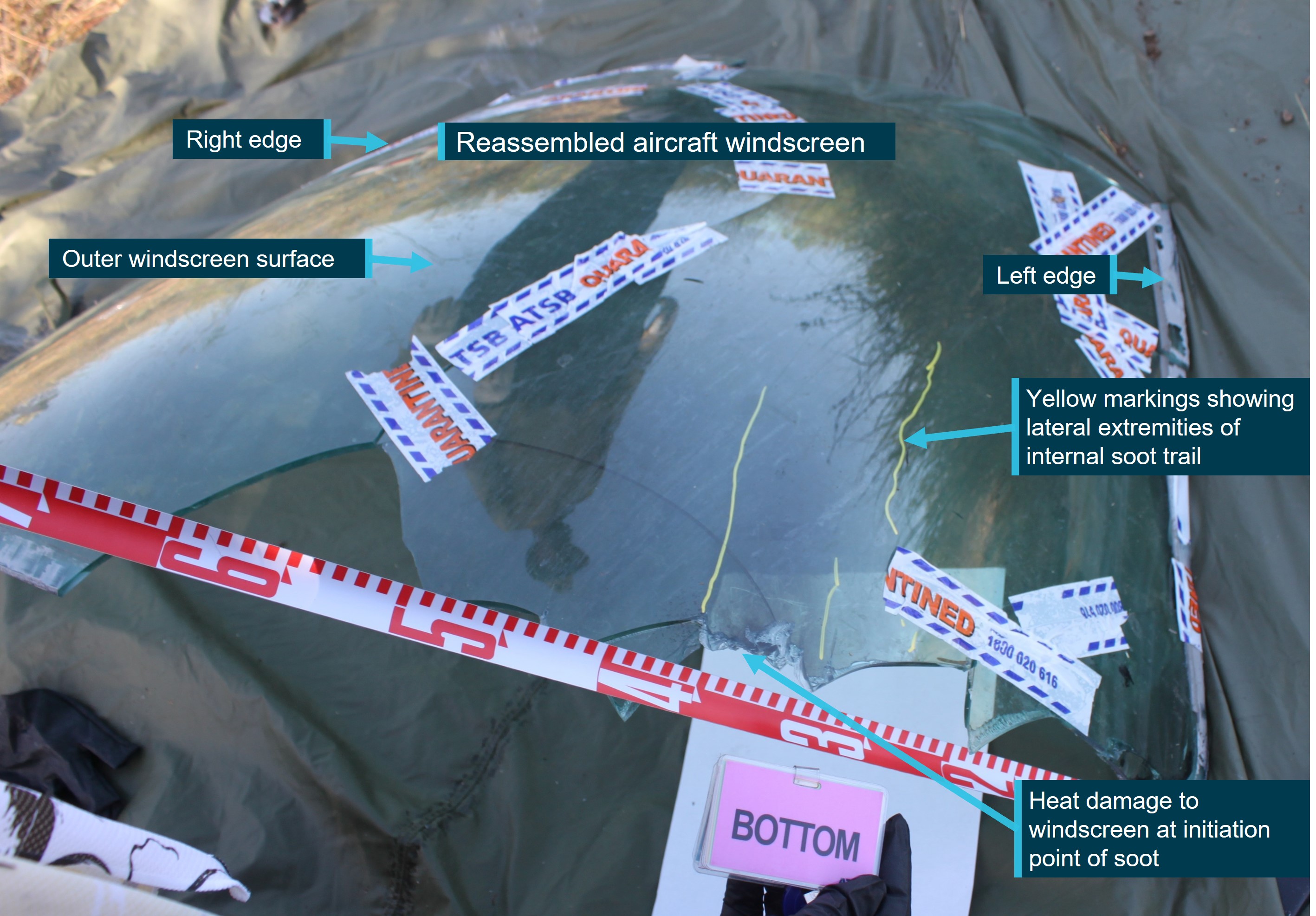
Due to environmental conditions on-site the soot trail was not easily visible in captured image. The outside surface of the windscreen was subsequently marked on site with yellow paint marker identifying lateral extremities of the soot trail.
Source: ATSB
The upper, aft corner of the pilot’s storm window surround (Figure 9) was located with the outer surface down, closer to the post‑impact fire than the windscreen. Soot was located on both sides with the external surface, consistent with soot being drawn out of the window by the airflow.
Figure 9: Smoke and soot indications on window surfaces adjoining the pilots storm window
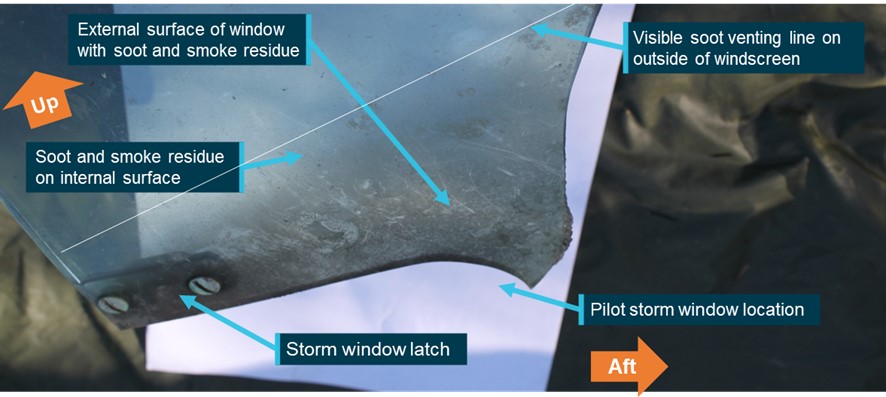
Source: ATSB
Flaps
Due to fire damage to the flap actuators, the specific position of the flaps at impact was unable to be determined. The aircraft’s flap tracks were recovered for further examination at the ATSB’s technical facilities in Canberra. Impact markings on the flap tracks indicated that the flaps were likely extended to the first of the 2 flap positions (15°) at the time of impact (Figure 10). This corresponded with both the pilot’s report of having extended the flaps one position prior to activating the landing gear and the operator’s procedures that required first stage flap extension as part of the setup of the aircraft for the approach.
Figure 10: Left inboard flap track with markings indicating likely flap position at impact
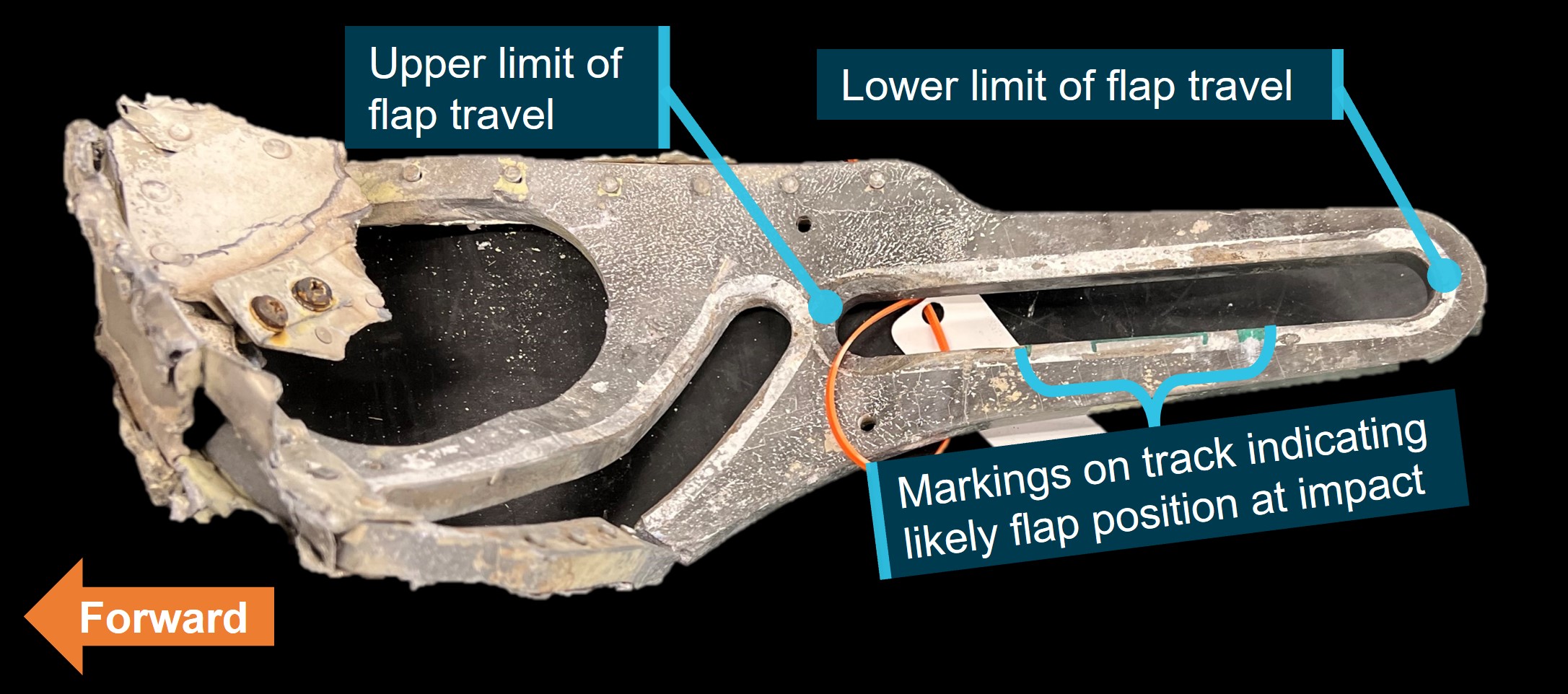
Source: ATSB
Possible tree strike
In response to witness reports that the aircraft skimmed trees prior to the ground collision, the operator conducted an airborne search on the western side of the Ord River. This search identified a grouping of 4 trees in the approach to runway 12 that had damage consistent with aircraft contact.
The trees were approximately 500 m west of the river and 60 m north of the extended runway 12 centreline (Figure 11). Their position was consistent with the aircraft’s approach path, and were close to the lowest point in the aircraft’s flight path data on the western side of the Ord River. Tree damage was between 15 and 20 ft above ground level and the direction of the breaks and fallen limbs were consistent with the aircraft’s direction of travel.
Figure 11: Possible tree strike location
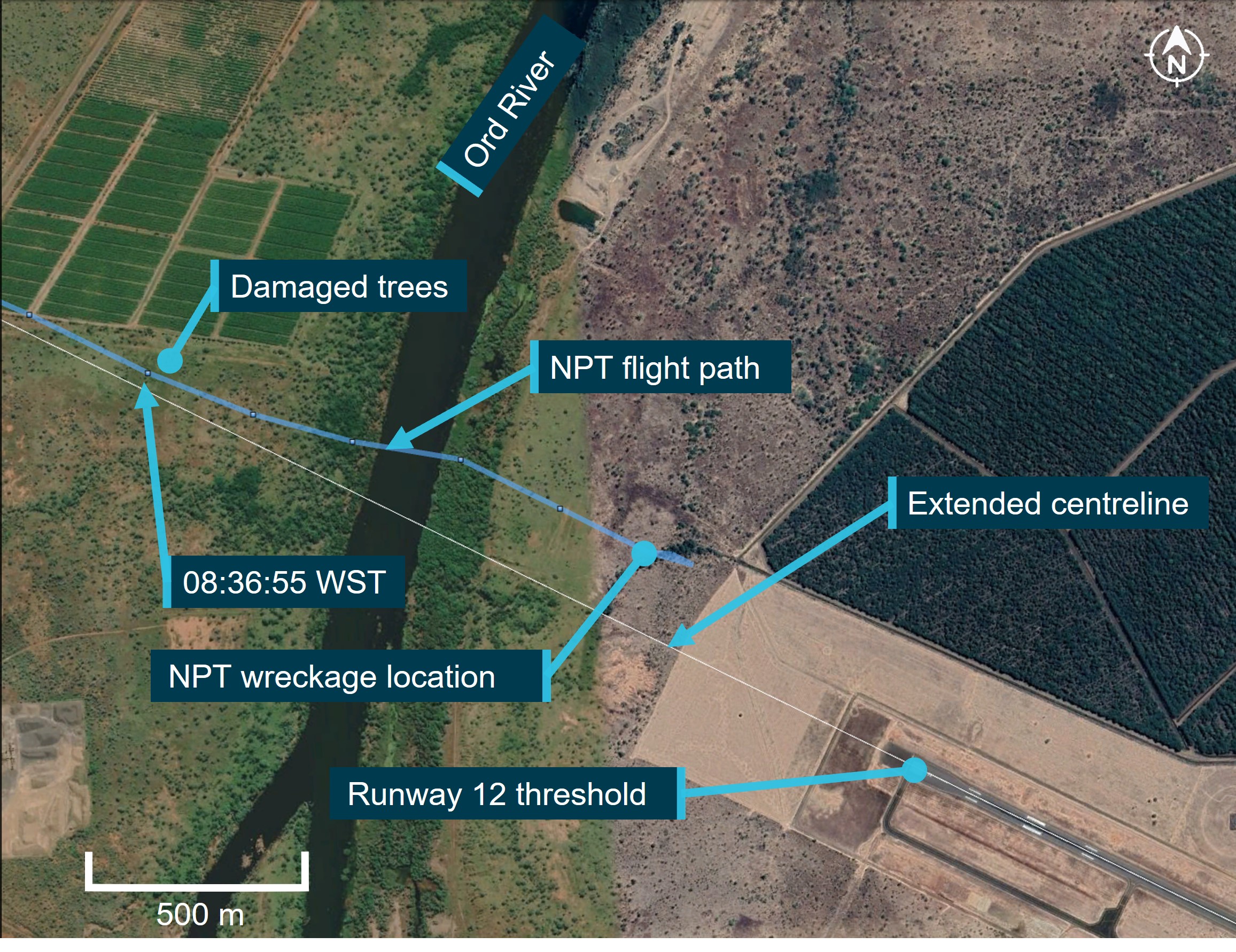
Source: Google Earth, Operator, AvPlan and Airservices Australia, annotated by the ATSB
Other than evidence of a collision with a number of small trees at the accident site, no additional tree strikes were identified, and no evidence of a foliage strike was located on the wreckage, however the significant fire damage prevented a detailed examination.
Pilot information
The pilot held a current Commercial Pilot License (Aeroplane), with their last flight review conducted in December 2021. They also held a:
- Class 1 aviation medical certificate, valid until January 2023
- multi engine aircraft instrument rating with retractable undercarriage and manual propellor pitch control endorsements.
Prior to the accident flight, the pilot had accumulated approximately 2,482 hours of aeronautical experience, of which just over 120 hours were in command of the B58. The pilot had completed their most recent operational proficiency check on 9 January 2022 and a line check in the B58 was carried out on 25 January 2022.
Meteorological information
An aerodrome meteorological report (METAR[7]) was issued by the automatic weather station at East Kimberley Regional Airport approximately 7 minutes before the accident. The report showed fine weather, with winds from the north at 2 kt, visibility greater than 10 km and nil cloud detected.
The ATSB also reviewed CCTV footage from the East Kimberley Regional Airport, which captured the smoke plume from the accident. Figure 12 shows the location of a camera covering the regular public transport apron. The camera image showed a smoke plume rising near-vertically from the accident site approximately 3 minutes after the accident indicating little to no wind immediately after the accident, consistent with the METAR.
Figure 12: Location of CCTV camera
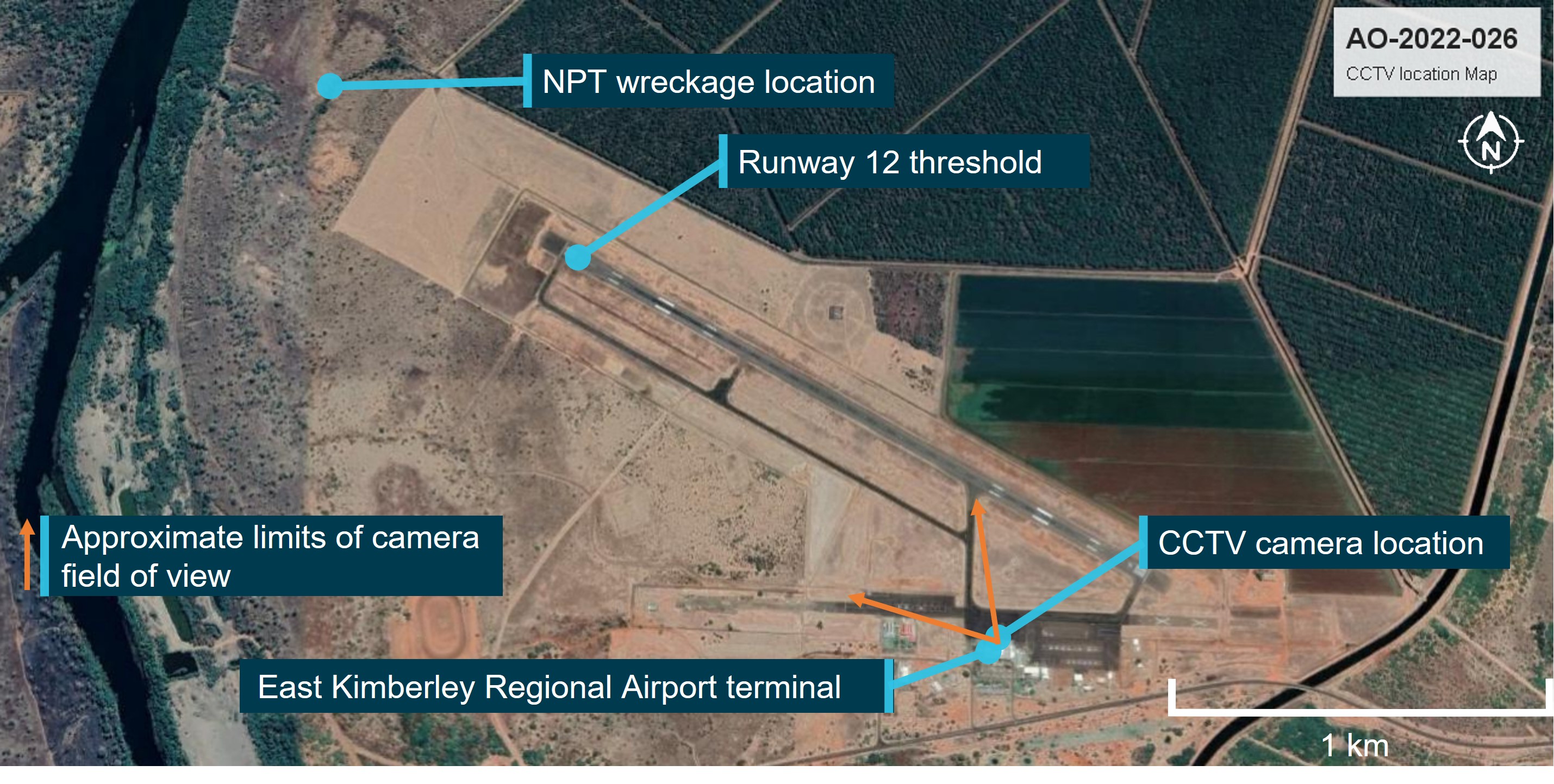
Source: Google Earth annotated by the ATSB
Survivability
In reviewing the survivability aspects of this accident, the ATSB sought expert guidance from the Royal Australian Air Force Institute of Aviation Medicine (IAM). Their report formed the basis of the following section.
Restraints
Injuries to aircraft occupants arising from traumatic contact with aircraft structure occur at least 5 times more often than acceleration‑related injury. Within small aircraft that have confined interiors, lap belts and upper torso restraints are critical to crash survivability for both crew and passengers. The restraint of the upper body serves 2 purposes:
- reducing the likelihood of impacting structures by minimising body flailing
- distributing forces more widely across the body, making them more likely to be survivable.
Upper torso restraints can be provided with a single shoulder strap, like that used in a car seatbelt or 2 straps, one over each shoulder. Figure 13, below, shows the difference between 2-, 3- and 4-point restraints. The image also shows a 5-point restraint that has a crotch strap which provides additional protection for the wearer, preventing them from ‘submarining’ or sliding under the lap portion of the restraint.
Figure 13: Aircraft restraint types.
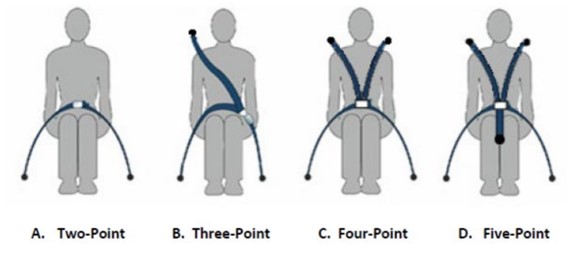
Source: United States Department of the Interior via IAM
Both 3- and 4-point harnesses restrain the upper torso. However, the 3-point only provides lateral restraint in one direction, if the person flails to the unrestrained side they may come out of the shoulder strap rendering it ineffective. Additionally, with only one strap over the torso, the 3‑point restraint has a smaller surface area than the 4-point, increasing the force exerted to the restrained area on the wearer.
In accordance with Civil Aviation Safety Regulation (CASR) 90.105 the flight crew seats must be fitted with a restraint that consists of a lap belt and at least one shoulder strap. Requirements for occupant restraints are outlined in CASR 90.110 and require all occupant seats for aircraft with less than 10 seats and manufactured after 13 December 1986 to be fitted with an approved seat belt and shoulder harness.
Seating
It is generally accepted that in the event of a frontal impact a rearward facing seat will increase survivability in two ways.
- Spreading the impact force over the entire surface of the back rather than specific areas where a restraint is positioned.
- Limiting the movement of the head through flexion and extension of the neck, provided the seat is fitted with an appropriately positioned headrest.
There is no Australian regulatory requirement for the use of rearward facing seats. Their use is subject to availability and based on a range of operational considerations. These include weight and balance, emergency egress, other payload items (cargo), company procedure and passenger and pilot comfort. The ATSB recovered all seat frames from the aircraft wreckage. However, due to the severity of the post‑impact fire the ATSB was not able to conduct a detailed assessment and determine their effectiveness in attenuating impact forces and any subsequent effect on survivability.
Injuries
IAM reviewed the hospital and post-mortem records of the pilot and passenger respectively and provided a summary of their injuries. Both the passenger and the pilot received injuries attributable to both the fire and the collision with terrain. While there were some similarities in the injury profiles, the passenger’s injuries included more severe burns and trauma to the neck and chest, consistent with a single shoulder restraint and flailing within the aircraft, that the pilot did not suffer.
Recorded data
Spider Tracks
The last non-SOS Spider Tracks data point, available to the nearest minute was recorded at 0835. Immediately after this, still at 0835, two ’SOS Opened’ data points were recorded, indicating that the SOS function has been activated. No further data was received by the operator.
The SOS function increases the frequency of the data transmissions to 10-15 second intervals rather than the standard 2 minutes. Data from the pilot’s electronic flight bag (EFB) application indicated that the aircraft collided with terrain at 0837. If the Spider Tracks unit had remained powered after the 2 SOS data points at least 8 further transmissions should have been received. If the activation of the SOS function had not triggered the increase in data frequency, then one more point may have been received at 0837, depending on the exact time that the 0835 data point was transmitted.
The operator advised that the Spider Tracks unit was connected to aircraft power and the loss of signal from the Spider Tracks indicated a loss of electrical power to the aircraft.
Electronic flight bag
The operator utilised the AvPlan EFB application for pilots to undertake flight planning tasks, access electronic information, such as charts or relevant documentation and depending on the settings, display nearby traffic. The application can also record aircraft position information at 5‑second intervals. The pilot of NPT had a device with the application installed and active for the flight, for which the ATSB received data. This provided multiple flight parameters including ground speed and tracking details for the aircraft from the time of take-off until it collided with terrain.
The device was powered by an internal battery. However, it could be connected to aircraft power to keep the battery charged. The loss of aircraft power would not reduce the functionality of the device or effect the data recorded while the battery maintained its charge.
ADS-B
The aircraft was fitted with a transponder that broadcast ADS-B[8] data to ground stations and nearby aircraft fitted with ADS-B IN. The ATSB retrieved the data transmitted by this unit from ground stations operated by both Airservices Australia and other third-party receivers, including one at the East Kimberly Regional Airport.
Data obtained from the receivers operated by Airservices Australia and several third-party receivers, recorded the aircraft’s location from Broome until 0835 when the aircraft started the approach to runway 12 at East Kimberley Regional Airport. The signal was then lost, likely due to the aircraft’s descent taking it below the coverage altitude for these receivers.
An ADS-B receiver at the East Kimberley Regional Airport received data from the aircraft between 0834 and 0837. This recorded the aircraft passing KNXWF and commencing the approach to the East Kimberley Regional Airport. The final position report was received at 0836:43. Between 0836:43 and 0837:12 eight more data packets were received containing NPT’s mode S transponder code, however position information was not included.
The aircraft was fitted with a GTX33 ADS-B transponder unit, which was not equipped with an internal backup battery.
Related occurrences
The ATSB identified one occurrence in Australia and 3 in the United States that had similarities to this accident. These 4 occurrences involve in-flight fires accelerated by combustible hydrocarbons that were initiated by damaged electrical wiring. Each of these fires were different, with 2 relating to direct feeding fuel and oil gauges (which NPT was not fitted with), one was an engine fire, and one was a cockpit fire that was controllable. While different in detail, they all demonstrate the risks when electrical wiring and combustible hydrocarbons such as fuel and oil are in proximity.
AO-2014-040
On 26 February 2014 at about 1645 local time, a Beech 58 aircraft, registered VH‑SBS, departed Darwin for Gove, Northern Territory, on a private ferry flight with a supervising pilot and pilot in‑command-under-supervision (ICUS) on board.
At about 1815, the pilot flying ICUS saw smoke and flames by their left leg adjacent to the circuit breaker panel and immediately switched off the electrical master switch. The supervising pilot seated in the right seat took control of the aircraft and commenced an immediate descent. The pilot ICUS retrieved the fire extinguisher from underneath their seat and extinguished the fire.
An engineering inspection found electrical wiring penetrated through the heater supply fuel line causing it to arc and burn a hole in the fuel line. The wires had been bundled together and were rubbing on the fuel line.
NTSB investigations
Between 1983 and 2022 the NTSB’s public database identified 7 investigations where an inflight fire or explosion was listed as a factor. Of these, 3 were identified to be of particular relevance and are summarised below.
MIA00FA221
On 17 July 2000, approximately 7 minutes after departing Memphis Tennessee, the pilot of a B58 aircraft registered N158MT, serial number TH-1186, contacted ATC reporting that they had an electrical fire and were going to switch off the master. Following two further communications with ATC the aircraft collided with water at Arkabutla Lake. Witnesses reported seeing a ’vapor trail’ or ’dust’ coming from the aircraft. The pilot was fatally injured, and the aircraft was destroyed.
The NTSB investigation identified that the fire was likely the result of arcing of an electrical wire behind the pilot’s instrument panel and associated heat‑related cracking to fuel and oil lines that feed direct reading pressure gauges for fuel and oil pressure in the cockpit. The investigation also identified that the pilot had not switched off the engine alternator switches in accordance with the electrical smoke and fire emergency checklist.
SEA02FA023
During take-off, on 2 January 2002, the pilot of a B58 aircraft registered N132Z, serial number TJ‑284, identified a fire in the aircraft’s left engine. The pilot reduced power and landed the aircraft on the remaining runway. The pilot and the passenger evacuated the aircraft, which sustained substantial damage.
Further inspection identified that an improper clearance had allowed an alternator wire to chafe against a pneumatic line in the engine bay. The exposed wire subsequently arced to the aluminium line igniting fuel vapor. The most probable cause of the accumulated fuel vapor was from a fuel cell leak that had previously been repaired.
ERA11FA312
On 25 May 2011, a B58 aircraft, registered N77AR, serial number TH-757, with a pilot and 3 passengers on board was conducting a flight from Atlanta, Georgia to Hazard, Kentucky. At 1612 local time the pilot contacted ATC to advise they were declaring an emergency due to a fire on board. No further radio transmissions were received. ATC recorded 7 further transponder and 2 primary radar returns. Several witnesses observed the aircraft in its final stages of flight before it collided with terrain at approximately 1613 local time. The 4 occupants were fatally injured, and the aircraft was consumed by a post‑impact fire.
The NTSB investigation identified that an in-flight fire likely initiated in the right front cockpit area forward of the instrument panel and below the glare shield. While the NTSB was unable to conclusively determine the origin of the fire, their analysis notes that the speed of the fire’s advance was consistent with a fuel fed fire. The analysis also identified that the area where the fire was believed to have initiated was an area that is near the direct‑reading oil pressure gauges.
This report noted that B58 and 58A models with serial number TH-001 through TH-1193 were fitted with direct‑reading fuel flow and pressure indicators in the cockpit. Direct‑reading pressure indicators use a direct line from the engine to the cockpit for presentation of engine fuel pressure. The report noted that aircraft with serial number TH-1194 and later (NPT serial number TH-1769) were fitted with remote fuel flow indicators, removing the need for fuel lines to go directly to the cockpit.
Safety analysis
Introduction
At 0834 local time on 16 April 2022, the pilot of B58 Baron aircraft registered VH-NPT commenced a straight in approach to runway 12 at the East Kimberley Regional Airport at Kununurra. During the approach the pilot declared a PAN-PAN to air traffic control reporting smoke and suspected fire in the aircraft’s cockpit.
The pilot continued the approach, diverging from the runway centreline track as they crossed the Ord River. The aircraft collided with terrain on the eastern side of the Ord River approximately 800 m from the runway 12 threshold. The passenger sustained fatal injuries and the pilot sustained serious injuries.
The following analysis will examine the in-flight fire, looking at the sources of initiation and acceleration, the pilot’s loss of visual cues and factors that affected survivability.
In-flight fire
The pilot reported that smoke and subsequently flame emerged from below the left side of the instrument panel, below and forward of the circuit breaker panel. The pilot attempted to extinguish the fire with a portable handheld fire extinguisher. The extinguisher suppressed the fire, however once removed, the fire returned vigorously.
Within 90 seconds of the pilot declaring the PAN-PAN, the aircraft had collided with terrain. The pilot sustained serious burns to their left side and the pilot and passenger sustained fire‑related respiratory injuries.
Materials used in the interior trim of NPT were required to be flame-resistant. The fire progressed at a speed greater than what would be expected of flame-resistant materials, consistent with the fire being fuelled by an accelerant.
Acceleration
Several lines and multiple looms of electrical wiring pass through the area where the pilot reported that the fire initiated. The lines contain pitot and static air for instruments, air conditioning system gasses and the fuel line to the aircraft’s cabin heater. Of these, the fuel line to the cabin heater provided the only source for flammable liquid to accelerate the fire.
A breach in the fuel line forward of and below the pilot’s circuit breaker panel would allow fuel to enter the area behind the side wall trim panel, possibly being absorbed by the fibreglass insulation. This would provide a high energy acceleration source capable of overcoming the flammability resistance of the trim materials. A direct examination of the line, surrounding insultation and the trim panel was not possible due to the post impact fire. As a result, the integrity of the heater line was unable to be established.
Two possible scenarios were considered for when a breach in the fuel line may have occurred. The first was that the leak was initiated at the time the pilot detected the smoke. This would show significant similarity to the previous Australian occurrence (AO-2014-040) whereby the breach in the fuel line initiated and provided an accelerant for the fire. However, in the 2014 occurrence, the leak was small, and the fire was comparatively controllable. In the event of a larger breach, or the line fracturing, fuel would be liberated more quickly, decreasing the chances of controlling the fire effectively.
The second scenario considered fuel to have been leaking for some time prior to the initiation of the fire. If the fuel had been leaking previously this would allow accelerant to accumulate behind the trim panel and in the insulation. In this scenario a smaller leak could lead to the same issues controlling the fire as a larger breach occurring due to the accumulated fuel.
The pilot’s report of a ‘fuel like smell’ in the cockpit on the morning of the accident may support the line having been breached at some point prior to the aircraft taking off. However, the pilot reported that the smell was no longer present once airborne. Additionally, there was no reported evidence of fuel spillage on the ground and the aircraft had passed its fuel leak check following maintenance 18 flight hours earlier.
Due to the post impact fire damage the ATSB was unable to determine which of the 2 scenarios were more likely. However, once the fire was initiated, given its location, it would very likely have quickly burned through the heater line liberating fuel that remained in the line further accelerating the fire and contributing to its rapid return after the pilot suppressed it with the portable handheld fire extinguisher.
Initiation
The electrical burning smell reported by the pilot immediately before the smoke and subsequent flames were observed supports the fire being initiated by a fault in the electrical system. The pilot reported that all systems had been operating normally until the landing gear handle was selected to the down position. Following the operation of the landing gear handle the pilot reported that the landing gear did not extend and there were multiple abnormal landing gear system indications.
Wiring for both the indication and operational systems are contained in wiring looms that pass through the area where the pilot first observed the smoke. These looms run near one another and the aircraft structure. Undetected damage could occur to or within the wiring looms, providing an ignition source from chafing, overheating of wiring or wires shorting to another wire or the airframe. Due to the destruction of the aircraft wreckage the ATSB was not able to determine the exact sequence of events that led to the electrical fault, the initiation of the fire and the other electrical anomalies that occurred.
Despite that, previous occurrences in both Australia and the United States show the danger that damaged electrical wiring can pose in areas with flammable liquid lines.
Loss of visual cues
As the fire advanced it generated a large amount of heat and smoke in the cockpit as reported by the pilot and evidenced by the soot on the internal surfaces of the aircraft windscreen and the pilot’s storm window surround, both of which were separated from the post‑impact fire. The extent of this smoke likely prevented the pilot from being able to see visual cues external to the aircraft or to effectively use the instruments as a reference. That situation, combined with the direct heat of the fire, meant that the pilot was presented with significant difficulty retaining control of the aircraft.
Following the PAN PAN call the aircraft descended below the normal approach profile; however, the pilot was able to maintain the approach track until crossing the Ord River when the aircraft diverged to the left of the extended runway centreline. The pilot was subsequently able to regain the approach heading prior to the aircraft colliding with terrain.
Survivability
The survivability of the accident can be broken down into the environment within the aircraft prior to and after the collision and the impact forces related to the collision.
The fire generated significant heat and smoke in the aircraft’s cockpit. The reports of the pilot and the respiratory injuries to both occupants indicate that they were unable to effectively vent the smoke.
With the pilot able to self-extract after the collision, the passenger continued to be exposed to the environmental conditions within the aircraft until the pilot was able to re-enter the aircraft to extract them. This likely reduced the passenger’s chances of survival.
The pilot reported that they and the passenger were secured in their restraints at the time the aircraft collided with terrain. The pilot, in the left control seat was in a 4-point harness and the passenger, in the rear right seat, was in a 3-point harness. Generally, the 4-point harness improves survivability in 2 ways. Firstly, it better attenuates the impact forces, by spreading them more broadly over the body. Secondly, it secures the occupant more effectively laterally reducing flailing. This decreases the likelihood of injuries due to contact with obstructions or structure of the aircraft.
The primary difference in injuries between the 2 occupants of the aircraft was the chest and other trauma present in the passenger. This trauma was consistent with the differences between the use of a 3-point and 4-point restraint. The 3-point restraint did not distribute forces as evenly across the body and allowed significant multi-directional movement (flailing) inside the aircraft.
Based on advice from the manufacturer, operator and ATSB research a 4-point restraint is not available for the rear seat of B58 aircraft. However, this accident demonstrates the fitment of the 4-point harness to the crew seats, can improve survivability over the 3-point restraint that is required under the regulations.
Seating position
NPT was fitted with a club passenger seating configuration, with 2 forward facing and 2 rearward facing seats. As the pilot and passenger were seated in forward facing seats a comparison of injury profiles due to forward or rearward facing seats was not possible. However, the available literature supports that in the event of a frontal impact the rearward facing seat will provide better restraint of the occupant. By both spreading impact force more evenly over the whole back and reducing the potential for flailing by forcing the body into the seat.
For this flight, the ATSB reviewed the weight and balance documentation, determining that the aircraft remained within limits regardless of where the passenger or the cargo were positioned. Additionally, due to the size of the cabin, the passenger’s emergency egress route would not have been altered by changing positions.
Recognising that, when flight planning, pilots have many operational considerations when it comes to passenger positioning, in the event of a frontal impact, such as a collision with terrain, a rearward facing seat will generally better protect the occupant and increase their chances of survival.
Findings
|
ATSB investigation report findings focus on safety factors (that is, events and conditions that increase risk). Safety factors include ‘contributing factors’ and ‘other factors that increased risk’ (that is, factors that did not meet the definition of a contributing factor for this occurrence but were still considered important to include in the report for the purpose of increasing awareness and enhancing safety). In addition, ‘other findings’ may be included to provide important information about topics other than safety factors. These findings should not be read as apportioning blame or liability to any particular organisation or individual. |
From the evidence available, the following findings are made with respect to the In-flight fire and collision with terrain involving Beechcraft B58 Baron, VH-NPT near East Kimberley Regional Airport, Kununurra, Western Australia on 16 April 2022.
Contributing factors
- On approach to runway 12 at Kununurra, a fault associated with the landing gear electrical system likely ignited fuel from the cabin heater supply line, resulting in a significant and sustained cockpit fire.
- Due to smoke in the cockpit, the pilot lost visual reference to both the instruments and outside environment. This, combined with the direct exposure to flames, led to a divergence from the extended runway centre line and the aircraft impacting terrain off the airfield.
Other findings
- The 4-point harness that was installed for the pilot provided better restraint and attenuation of impact forces compared to the best available option of a 3-point restraint in the rear, leading to less severe impact related injuries.
- The aircraft’s passenger cabin had a ‘club’ configuration with 2 forward and 2 rearward facing seats. Although not a requirement, positioning the passenger in rearward facing seat would have likely improved survivability from frontal impact‑related injuries.
Safety action
| Whether or not the ATSB identifies safety issues in the course of an investigation, relevant organisations may proactively initiate safety action in order to reduce their safety risk. All of the directly involved parties are invited to provide submissions to this draft report. As part of that process, each organisation is asked to communicate what safety actions, if any, they have carried out to reduce the risk associated with this type of occurrences in the future. The ATSB has so far been advised of the following proactive safety action in response to this occurrence. |
Safety action by Aviair Pty Ltd.
In response to this accident the operator reported that they
- commenced a program to install 4-point restraints in the crew seats of all their B58 aircraft
- installed an additional fire extinguisher in each of their B58 aircraft,
- incorporated additional 100-hourly fuel line and wiring inspections in the vicinity of the heater fuel line and circuit breakers adjacent to the pilot’s seat.
Safety advisory notice to operators of B58 aircraft
In conjunction with the preliminary report released on 21 September 2022, the ATSB issued a Safety Advisory Notice to all B58 operators encouraging them to:
- note the circumstances of this accident and previous ATSB investigation AO‑2014‑040
conduct a detailed examination of the wiring and fuel line on the left side of the aircraft forward of, and below, the pilot’s circuit breaker panel.
A copy of the Safety Advisory Notice can be found on the ATSB website here.
ATC Air traffic control
ADS-B Automatic Dependent Surveillance - Broadcast
CASA Civil Aviation Safety Authority
CASR Civil Aviation Safety Regulations
CCTV Closed-circuit television
EFB Electronic Flight Bag
FL Flight level
KNXWF Approach point Kununurra Whiskey Foxtrot
METAR Aerodrome meteorological report
IAS Indicated airspeed
IAM Royal Australian Air Force Institute of Aviation Medicine
Sources and submissions
Sources of information
The sources of information during the investigation included the:
- pilot and operator
- Civil Aviation Safety Authority
- Western Australia Police Service
- aircraft manufacturer
- Airservices Australia
- accident witnesses
- CCTV footage and ADS-B data recorded at the East Kimberley Regional Airport
- recorded data from AvPlan electronic flight bag application on the pilots iPad.
- Royal Australian Air Force Institute of Aviation Medicine
Submissions
Under section 26 of the Transport Safety Investigation Act 2003, the ATSB may provide a draft report, on a confidential basis, to any person whom the ATSB considers appropriate. That section allows a person receiving a draft report to make submissions to the ATSB about the draft report.
A draft of this report was provided to the following directly involved parties:
- pilot of the accident flight
- operator
- Civil Aviation Safety Authority
- aircraft manufacturer
- Royal Australian Air Force Institute of Aviation Medicine
Submissions were received from the:
- pilot of the accident flight
- operator
- aircraft manufacturer
The submissions were reviewed and, where considered appropriate, the text of the report was amended accordingly.
Purpose of safety investigationsThe objective of a safety investigation is to enhance transport safety. This is done through:
It is not a function of the ATSB to apportion blame or provide a means for determining liability. At the same time, an investigation report must include factual material of sufficient weight to support the analysis and findings. At all times the ATSB endeavours to balance the use of material that could imply adverse comment with the need to properly explain what happened, and why, in a fair and unbiased manner. The ATSB does not investigate for the purpose of taking administrative, regulatory or criminal action. TerminologyAn explanation of terminology used in ATSB investigation reports is available here. This includes terms such as occurrence, contributing factor, other factor that increased risk, and safety issue. Publishing informationReleased in accordance with section 25 of the Transport Safety Investigation Act 2003 Published by: Australian Transport Safety Bureau © Commonwealth of Australia 2023
Ownership of intellectual property rights in this publication Unless otherwise noted, copyright (and any other intellectual property rights, if any) in this report publication is owned by the Commonwealth of Australia. Creative Commons licence With the exception of the Coat of Arms, ATSB logo, and photos and graphics in which a third party holds copyright, this publication is licensed under a Creative Commons Attribution 3.0 Australia licence. Creative Commons Attribution 3.0 Australia Licence is a standard form licence agreement that allows you to copy, distribute, transmit and adapt this publication provided that you attribute the work. The ATSB’s preference is that you attribute this publication (and any material sourced from it) using the following wording: Source: Australian Transport Safety Bureau Copyright in material obtained from other agencies, private individuals or organisations, belongs to those agencies, individuals or organisations. Where you wish to use their material, you will need to contact them directly. |
[1] PAN-PAN: an internationally recognised radio call announcing an urgency condition which concerns the safety of an aircraft or its occupants but where the flight crew does not require immediate assistance.
[2] SOS function is an emergency transmission from the Spider Tracks unit that alerts predetermined personnel via text message that an aircraft is in distress and an emergency response is likely to be required.
[3] Spider Tracks is a subscription aircraft monitoring service that allows operators to track and monitor the location of aircraft at 2 minute intervals. The location is recorded and transmitted by a unit that is fitted to the aircraft. This unit also has ’Watch’ and ’SOS’ functions that allow the pilot to alert predetermined ground-based personnel of a situation requiring monitoring or an emergency situation.
[4] Storm Window is a small window inset in the pilot’s side window allowing ventilation, or visibility in the event it is lost through the forward windscreen
[5] Club configuration – the forward two seats in the rear passenger area are oriented to face the rear of the aircraft while the rear seats face forward.
[6] Landing gear limit switch prevents overdriving of the landing gear motor by disconnecting motor drive to the gear once it reaches the extended or retracted and locked positions.
[7] METAR - a routine aerodrome report of meteorological conditions at an aerodrome, normally issued on the hour and half-hour.
[8] Automatic Dependent Surveillance – Broadcast - A means by which aircraft, aerodrome vehicles and other objects can automatically transmit and/or receive data such as identification, position and additional data, as appropriate, in a broadcast mode via a data link







